Scythe Andy Samurai Master vs. Thermaltake MaxOrb
by Wesley Fink on June 4, 2007 5:00 AM EST- Posted in
- Cases/Cooling/PSUs
Thermaltake MaxOrb
Thermaltake started business in 1999 in Taiwan, and has since become one of the most recognized brands in computer cooling as well as cases. Since 1999 the company has grown into a world-class company with a state-of-the-art testing and R&D facility based in Taiwan. Thermaltake employs 60+ engineers covering each application segment such as Liquid Cooling, Air Cooling, PC Enclosure and Power Supply for main-stream users, high-end solutions, system integrators and industrial applications. Today you will find Thermaltake cooling solutions around the world.
The MaxOrb is the latest in a long line of Thermaltake "orb" coolers. The Orb name was first used in 2000 when Thermaltake launched the Golden Orb cooler for Pentium processors. The name has been revived recently with the MaxOrb cooler, which combines radial fins and heatpipes in a down-facing CPU cooler.
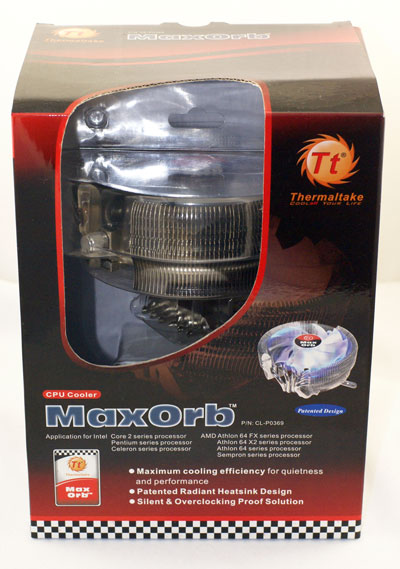
This cooler stands out with distinctive red and black packaging, and the package itself is huge. The MaxOrb and a box of accessories are protected by a plastic clamshell inside the box.
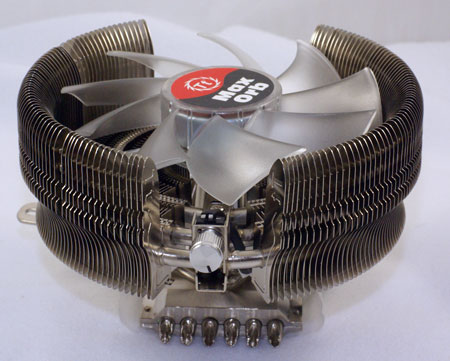
The cooler uses large radial aluminum fins and a large 110mm fan. As you can see there is also a built-in fan speed control that allows fan output to be adjusted up to a claimed 86.5cfm at 2000rpm. The embedded 110mm fan is lit by a blue LED. 110mm is a non-standard fan size, but that is somewhat a moot point since the fan was not designed to be changed.
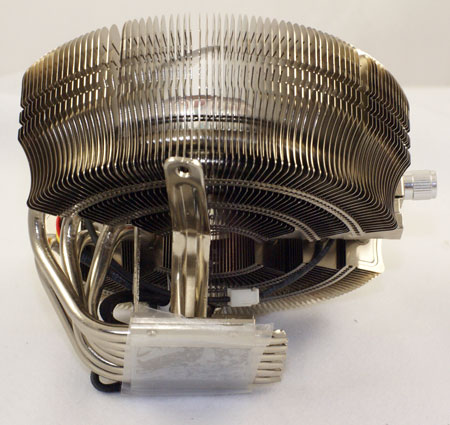
The cooling is further enhanced by six heatpipes extending from the copper base. These turn and pass horizontally through the radial fins to dissipate heat from the processor.
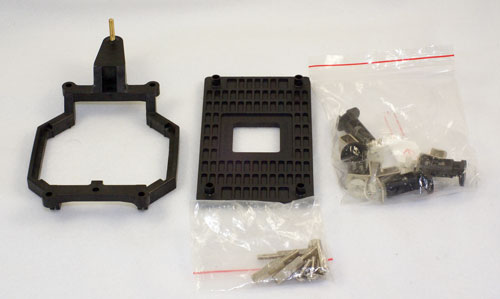
Accessories include mounting brackets for Intel socket 775 and AMD 754/939/940/AM2. The key component is the universal mounting base.
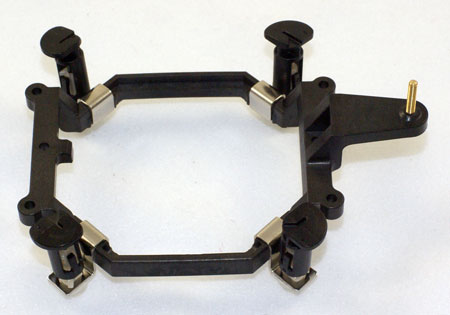
The base attaches the MaxOrb cooler, and four pop-clips slip onto the base for mounting to an Intel socket 775. You don't need to remove the motherboard to mount this cooler.
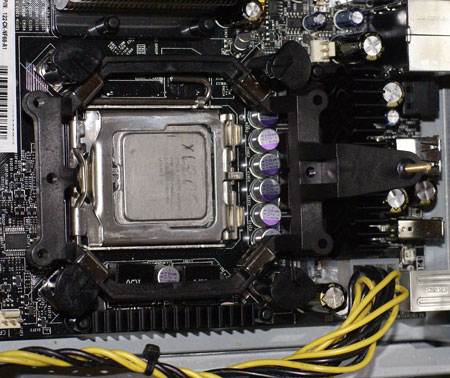
The base pops on first, then the cooler attaches by clipping to the base lug and attaching a single screw. Unlike other coolers that claim simple installation without board removal, this one actually works. The only awkward task is attaching the single screw since there's just no good way on a board mounted in a case to hold the screw while trying to screw it on.
Specifications
Our test system is Intel socket 775, but the Thermaltake MaxOrb will mount on any recent AMD socket as well - including socket 754/939/940 as well as the more recent and AM2. All the needed hardware is included.
The MaxOrb is a big cooler, but it is much shorter than the typical heatsink towers we have been reviewing. The EVGA 680i is a difficult to fit board due to the copper-finned heatsink and fan cooling the Northbridge. It is a snug fit, but the MaxOrb mounted fine on the 680i, the ASUS Striker and ASUS Commando, and on the two new P35 boards - the ASUS P5K Deluxe and P5K3 Deluxe. The P5K3 Deluxe is almost a fit test for any motherboard, since the heatpipes completely circle the CPU socket and connect various cooling heatsinks around the CPU socket. The only precaution on the P5K3 is to mount the MaxOrb with the screw "tongue" over the lower heatpipes near the DIMM sockets. It clears everything in this mount position.
Thermaltake started business in 1999 in Taiwan, and has since become one of the most recognized brands in computer cooling as well as cases. Since 1999 the company has grown into a world-class company with a state-of-the-art testing and R&D facility based in Taiwan. Thermaltake employs 60+ engineers covering each application segment such as Liquid Cooling, Air Cooling, PC Enclosure and Power Supply for main-stream users, high-end solutions, system integrators and industrial applications. Today you will find Thermaltake cooling solutions around the world.
The MaxOrb is the latest in a long line of Thermaltake "orb" coolers. The Orb name was first used in 2000 when Thermaltake launched the Golden Orb cooler for Pentium processors. The name has been revived recently with the MaxOrb cooler, which combines radial fins and heatpipes in a down-facing CPU cooler.

This cooler stands out with distinctive red and black packaging, and the package itself is huge. The MaxOrb and a box of accessories are protected by a plastic clamshell inside the box.

The cooler uses large radial aluminum fins and a large 110mm fan. As you can see there is also a built-in fan speed control that allows fan output to be adjusted up to a claimed 86.5cfm at 2000rpm. The embedded 110mm fan is lit by a blue LED. 110mm is a non-standard fan size, but that is somewhat a moot point since the fan was not designed to be changed.

The cooling is further enhanced by six heatpipes extending from the copper base. These turn and pass horizontally through the radial fins to dissipate heat from the processor.

Accessories include mounting brackets for Intel socket 775 and AMD 754/939/940/AM2. The key component is the universal mounting base.

The base attaches the MaxOrb cooler, and four pop-clips slip onto the base for mounting to an Intel socket 775. You don't need to remove the motherboard to mount this cooler.

The base pops on first, then the cooler attaches by clipping to the base lug and attaching a single screw. Unlike other coolers that claim simple installation without board removal, this one actually works. The only awkward task is attaching the single screw since there's just no good way on a board mounted in a case to hold the screw while trying to screw it on.
Specifications
Our test system is Intel socket 775, but the Thermaltake MaxOrb will mount on any recent AMD socket as well - including socket 754/939/940 as well as the more recent and AM2. All the needed hardware is included.
| Thermaltake MaxOrb Specifications | ||||
| Heatsink | ||||
| Dimensions | 143(L) X 114(D) X 85.2(H)mm | |||
| Weight | 465g (including fan) | |||
| Material | Pure Copper Base and Aluminum Fins | |||
| Heatpipes | Six 6mm copper heatpipes | |||
| Fan | ||||
| Fan Size | 110 mm x 25mm | |||
| Bearing Type | Sleeve Bearing | |||
| Fan Life | 50,000 hours | |||
| Connector | 3-pin with integral fan-speed rheostat, 3.0 Watt Input | |||
| Speed | Silent Mode | 1,300rpm | Low-noise Mode | 2,000rpm |
| Noise Level | Silent Mode | 16.0dBA | Low-noise Mode | 24.0dBA |
| Fan Output | Silent Mode | Low-noise Mode | 85.5cfm | |
The MaxOrb is a big cooler, but it is much shorter than the typical heatsink towers we have been reviewing. The EVGA 680i is a difficult to fit board due to the copper-finned heatsink and fan cooling the Northbridge. It is a snug fit, but the MaxOrb mounted fine on the 680i, the ASUS Striker and ASUS Commando, and on the two new P35 boards - the ASUS P5K Deluxe and P5K3 Deluxe. The P5K3 Deluxe is almost a fit test for any motherboard, since the heatpipes completely circle the CPU socket and connect various cooling heatsinks around the CPU socket. The only precaution on the P5K3 is to mount the MaxOrb with the screw "tongue" over the lower heatpipes near the DIMM sockets. It clears everything in this mount position.










50 Comments
View All Comments
Wesley Fink - Tuesday, June 5, 2007 - link
We now use a standard quality silver-colored paste in all our reviews. But in our experience and testing the thermal paste makes absolutely no difference in performance. The paste fills gaps and needs to remain fluid and not dry out.A famous review from several years ago showed toothpaste and Kraft Vegimite equal or superior to AS3 - at least until they dried out. The point was use a decent paste but don't obsess on it - as it really makes no difference. This is particularly true now that all the current CPUs use heatspreader covers and you no longer are mounting on a tiny die as you were on AMD Socket A.
rjm55 - Tuesday, June 5, 2007 - link
The review Wesley is talking about was at the Australian site Dan's Data at http://www.dansdata.com/goop.htm">http://www.dansdata.com/goop.htmChunga29 - Monday, June 4, 2007 - link
Whoa! Two articles today? Heh. I was just finishing the 2900 fiasco article and suddenly this shows up. [Big grin!]Only problem with the Hexus article is that overclocking isn't even a factor. I'm a bit confused as to their results, as they have the Zalman 9700 performing in the top of the tested HSFs, trailing the Tuniq by 1C. The AT results show Tuniq leading by 2C at load, but even more interesting is that the AT results are about 10C cooler on every HSF (at least where they overlap).
Oh... WAIT! The Hexus reviews are using a Pentium D Extrene 840!? What in the hell is up with that? Why don't we do some testing with the original Athlon FX-51 while we're at it? While most people won't purchase a $1000 CPU like the X6800, at least Core 2 Duo is very popular and many are OC'ing E6600 chips to similar levels (and beyond). Perhaps the VX is the best HSF when it comes to cooling Pentium D setups... but that's about as far as I'd take the Hexus roundup.
Honestly, I'd like only a few things from AnandTech cooling reviews:
1) Testing on AM2 as well as 775.
2) Temps of various components.
3) More HSFs! Heh. A roundup would be great.
Two HSFs in one ariticle is a start, but how about four or five similar HSFs at a time? Half the material is just filler (copy paste from previous articles), so other than the spec sheets, intro, conclusion, and charts there's not much going on here. Am I the only one that skims (at best) the middle pages?
DrMrLordX - Tuesday, June 5, 2007 - link
Hexus used a Pentium 840D because it's a stupidly hot processor that's cheap. Pentium Ds can easily put out as much heat as Kentsfields.Chunga29 - Tuesday, June 5, 2007 - link
I understand that. The problem is that performance with a Pentium Extreme 840 doesn't really tell you anything about how the cooler will perform with other processors. For what it's worth, a heavily overclocked Core 2 Duo X6800 (or better yet a QX6700) is also a stupidly hot processor. I'd wager that the output of QX6700 easily exceeds the 840EE.Testing with outdated equipment is meaningless, regardless of how hot the old parts get. That's why it would be ideal to see current AM2 performance as well. I remember a LOT of reviews hailing the Zalman 9500 as the greatest cooler ever, and while it appears to do great on AM2 it's pretty average on an overclocked C2D. I hope you can see that the same could easily be true of comparing performance with 840EE to current C2D and AM2 chips.
DrMrLordX - Wednesday, June 6, 2007 - link
Actually, uh, your point isn't really valid. A heavily OCed Smithfield can easily pump out heat like a heavily OCed Kentsfield. Heat is heat as long as its distributed properly by the IHS and properly-applied TIM.The age of the equipment in question is irrelevant unless a particular HSF has a mounting mechanism that is somehow better-suited to one socket or another, not that that's an issue when dealing with Smithfields and Kentsfields (both s775 processors).
Using a Smithfield to test the limit of modern HSFs is entirely appropriate, given its massive heat output that can still rival that of Kentsfields and its socket which is identical to the socket-type used with Conroe and Kentsfield processors.
Stele - Monday, June 4, 2007 - link
I second that, though especially no.(2). That would help decide between a traditional downdraught HSF blowing air onto the motherboard vs. the tower ones.
It might be useful to have a proper cross flow of air through the case too, e.g. one 120mm fan each for intake and exhaust. This would not only be more reflective of regular casing setups but would also ensure a level playing field - otherwise the tower ones may potentially have a greater advantage over the downdraught ones (since they can exhaust hot air out of the case through the case rear) than real-life setups may show.
How about including the Enzotech Ultra-X in a future review? Seems to be quite a good performer by all accounts! :P
Wesley Fink - Monday, June 4, 2007 - link
The MaxOrb is reputed to be at least the equal of the Big Typhoon VX in performance and it is a more recent design.We have an Enzotech Ultra-X in for testing. You will see it in a future review.
We had planned a big spread on board component temperatures, but when the down-facing fans didn't even come close to the heatpipe towers in cooling efficiency or overclcoking it became a moot point. IF the down fans really cooled better they would cool more efficiently and/or allow a higher overclock. Neither is the case in our tests. We run our top OC speed with a pretty hefty chipset voltage increase, and if the dowh-facers cooled components better we would get a better overclock, or at least an equal OC. Instead OC is average at best with all 3 expensive down-face designs.
DrMrLordX - Tuesday, June 5, 2007 - link
Reputed by who? Would it really kill you guys to review the Big Typhoon VX, or an older Big Typhoon with an FM-121?The Big Typhoon has had at least one other good showing here:
http://forum.abit-usa.com/showthread.php?t=103462">http://forum.abit-usa.com/showthread.php?t=103462
It beat the Tuniq Tower 120 pretty solidly there as well once it had a decent fan in it. Note that at least one of the fans that allowed the Big Typhoon to defeat the Tuniq Tower 120 has approxmiately the same cfm rating as the fan included with the Big Typhoon VX.
Chunga29 - Monday, June 4, 2007 - link
Addendum: it might be interesting (although it's too late now) to test with an E6600 instead of the X6800... maybe switch to a Q6600 in the future? When AM2 gets quad core (if it gets quad core?), I'd like to see head-to-head comparisons of HSfs on both platforms. Maybe retest the current leaders for reference (Ultra-120/eXtreme, Tuniq, Hyper6+, and a couple others?)